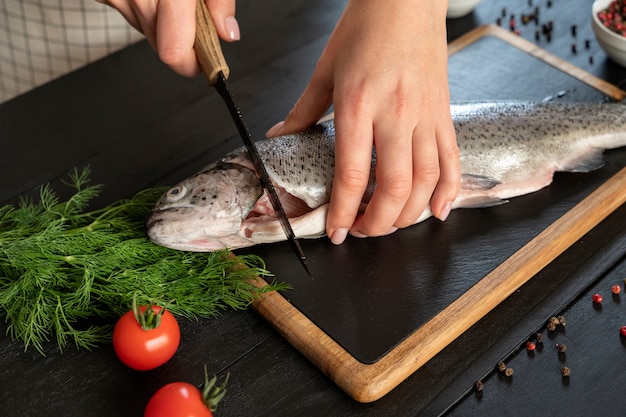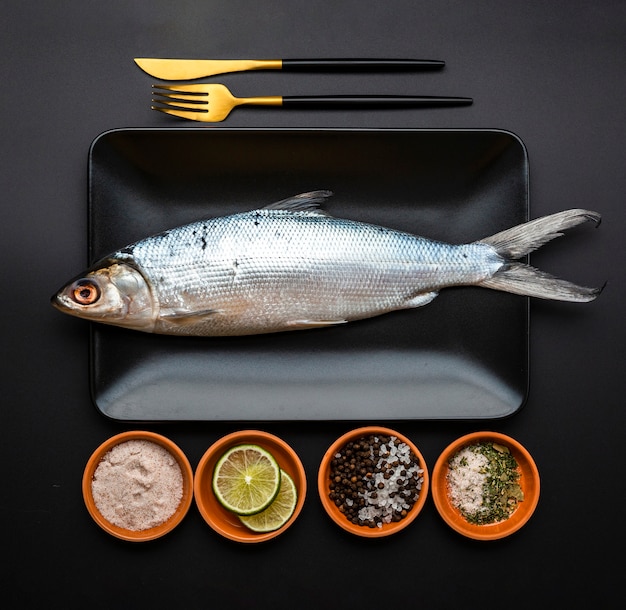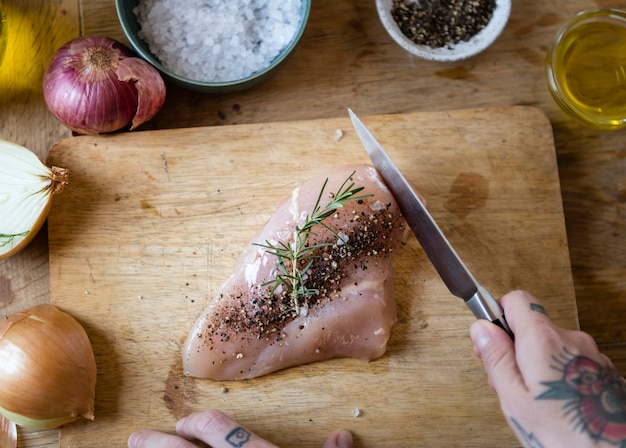Let’s be honest, white fish is a kitchen hero. It's incredibly versatile, cooks up quickly, and is a fantastic source of protein. But sometimes, you might find yourself staring at a piece of cod or haddock with a blank expression, wondering what to do with it. Fear not, my fellow food enthusiasts! This is your comprehensive guide to mastering the art of cooking white fish, from the sizzling pan to the warm embrace of the oven and everything in between.
Part 1: The Basics

Before we embark on this culinary adventure, let's lay down the groundwork. Think of these basics as the sturdy foundation upon which we'll build our fish-cooking expertise.
Choosing the Right Fish: Navigating the Ocean of Options
The first step is picking the perfect fish. I've always had a soft spot for the classics: cod, haddock, and basa. They're readily available, wallet-friendly, and boast that delicate, flaky texture that makes you sigh with contentment. But don't be afraid to venture beyond the familiar. There's a whole world of delicious white fish out there, including the likes of halibut, sea bass, and even pollock. Each possesses its unique charm and culinary personality.
Checking for Freshness: The Telltale Signs
You've got your fish, but how do you know it's fresh? Here's how to tell:
- The Eyes: A clear, bright, and moist eye is a sign of freshness. Avoid fish with cloudy, sunken eyes.
- The Gills: Fresh gills should be bright red, not dull or brown. A fishy smell coming from the gills is a sign of spoilage.
- The Flesh: The flesh should be firm to the touch and spring back when gently pressed. Avoid fish with soft, mushy flesh.
- The Smell: Fresh fish should have a mild, slightly briny smell. A strong, fishy, or ammonia-like odor is a clear sign of spoilage.
Preparing the Fish: Setting the Stage for Culinary Success
Now, you've got your fresh fish. It's time to prepare it for its star turn. If you're working with fillets, pat them dry with kitchen paper. You want a dry surface for optimal browning and a crispy skin. Don't hesitate to remove any pesky bones. A simple pair of tweezers will do the trick.
Part 2: Pan-Searing Perfection: Embracing the Sizzle

Pan-searing is a fantastic technique for achieving a beautiful, crispy crust on your fish while keeping the flesh tender and juicy. Think of it as a delicious marriage of texture and flavour.
The Equipment: Assembling Your Arsenal
You'll need a heavy-bottomed pan, preferably cast iron, for even heat distribution. A good quality non-stick pan also works wonders. Don't forget a trusty pair of tongs for effortlessly flipping your fish masterpiece.
The Method: A Step-by-Step Guide
- Heat the Pan: Fire up your pan over medium-high heat. A drizzle of olive oil should sizzle and shimmer when it hits the hot surface. This indicates the pan is ready for action.
- Season the Fish: Generously season your fish with salt and pepper. Don't be afraid to experiment with additional spices like paprika, garlic powder, or lemon zest, depending on your desired flavour profile.
- The First Kiss of Heat: Place the fish in the pan, skin-side down, and resist the urge to touch it for 3-4 minutes. This creates the beautiful golden-brown crust that will have your taste buds singing.
- Flip for Flavor: Carefully flip the fish using your tongs and cook for another 2-3 minutes, or until the flesh is cooked through. You can use a fork to gently check if the flesh flakes easily. This indicates it's reached perfection.
- Rest and Enjoy: Remove the fish from the pan and let it rest for a couple of minutes. This allows the juices to redistribute, resulting in a more tender and flavorful fish.
Tips for Pan-Seared Success: Avoiding Common Pitfalls
- Don't Crowd the Party: Give your fish some breathing room in the pan. Overcrowding can lead to uneven cooking and a less than stellar result.
- Patience is a Virtue: Resist the urge to move the fish around too much. Let it cook undisturbed, allowing the crust to form undisturbed. It's a testament to the power of patience.
- Mind the Heat: Keep a close eye on the heat. Too high, and your fish will burn. Too low, and it'll steam instead of sear. It's a delicate balance.
Part 3: Baking for Tenderness: A Gentle Approach to Flavor

Baking is a more relaxed method, perfect for achieving tender, flaky fish. It's the perfect choice for when you want to focus on other things while your fish cooks to perfection.
The Equipment: Simple Tools for Baking Brilliance
All you need is a baking sheet lined with parchment paper or foil for effortless cleanup.
The Method: A Simple Guide to Baked Perfection
- Preheat the Oven: Fire up your oven to 400°F (200°C). This ensures even cooking and preserves the delicate texture of your fish.
- Season with Flavor: Season your fish generously with salt, pepper, and any other spices or herbs that tickle your fancy. I love adding a squeeze of lemon juice or a drizzle of olive oil for an extra boost of flavor.
- Bake to Perfection: Place your fish on the baking sheet and bake for 12-15 minutes, or until the flesh is opaque and flakes easily with a fork. Baking times may vary depending on the thickness of your fish.
- Rest and Serve: Remove the fish from the oven and let it rest for a few minutes. This allows the juices to redistribute and enhances the tenderness.
Tips for Baked Brilliance: Unlocking the Secrets of the Oven
- Don't Overdo It: Overcooked white fish can become dry and rubbery. Keep a close eye on it and use a fork to check for doneness. It's better to err on the side of undercooked than overcooked.
- Temperature Check: For ultimate accuracy, use a meat thermometer. The internal temperature should reach 145°F (63°C) for safe consumption.
- Get Creative: Experiment with various flavourings. A sprinkle of breadcrumbs or a drizzle of lemon butter can elevate your baked fish to new heights. Don't be afraid to explore and let your imagination run wild.
Part 4: A Symphony of Flavors: Elevating Your White Fish Game
Now let’s talk about how to really turn up the dial on your white fish game. We're not just cooking fish here, we're creating a culinary masterpiece that will have your taste buds singing with delight.
Citrus Burst: A Zesty Fusion of Flavors
A squeeze of lemon, a drizzle of lime, a splash of orange juice - citrus is the perfect partner for white fish. It cuts through the richness, adds a bright acidity, and complements the delicate flavour of the fish. A simple squeeze of lemon over a pan-seared fish is all it takes to transform a meal into a symphony of flavors.
Herby Delights: Aromatic Enhancements
Fresh herbs are like the cherry on top of a perfectly cooked fish. Think dill, parsley, chives, or even a pinch of tarragon. Chop them up, sprinkle them over your fish just before serving, or incorporate them into a sauce or marinade for extra flavor. Their aromatic presence enhances the overall experience.
Spiced Adventures: A Touch of Heat and Complexity
Don't be afraid to spice things up! A pinch of paprika, a dash of cayenne pepper, or a sprinkle of smoked paprika can add a touch of warmth and complexity to your white fish. You can also create a spice rub with a blend of your favourite spices. Experimentation is key!
Part 5: side dishes to Delight: Complementary Companions
A good side dish is like a perfect harmony, complementing the main act and elevating the overall dining experience.
Starchy Stars: Comforting Classics
A bed of fluffy rice or creamy mashed potatoes is always a classic choice. They provide a comforting warmth and a textural contrast to the delicate fish.
Green Goodness: Refreshing Contrasts
A fresh salad or steamed vegetables like asparagus or broccoli add a refreshing contrast to the rich flavour of the fish. They provide a burst of color, texture, and vitamins, creating a balanced and delightful meal.
Carb-Free Options: Light and Wholesome
If you're looking for something lighter and healthier, try a side of roasted vegetables or a quinoa salad. These options offer a satisfyingly flavorful and nutritious complement to your white fish.
Part 6: Sauce Sensations: The Finishing Touch
A simple sauce can elevate your white fish to a whole new level of culinary bliss.
Lemon Butter Sauce: A Classic for a Reason
This is a classic for a reason. It's simple, flavorful, and complements the delicate flavour of the fish perfectly. It's a harmonious blend of tangy lemon and rich butter, adding a touch of decadence to your dish.
Creamy Garlic Sauce: Rich and Decadent
For a more decadent sauce, try a creamy garlic sauce. It's rich, creamy, and bursting with flavour. The creamy texture and pungent garlic create a perfect harmony of flavors.
Tomato Salsa: A Refreshing Burst of Flavor
If you're looking for something lighter and brighter, try a tomato salsa. It's a refreshing and vibrant addition to any white fish dish. Its fresh, tangy flavor adds a burst of acidity and freshness to your plate.
Part 7: Mastering the Art of Flaking: A Culinary Dance
Flaking is a skill, and a crucial one at that when it comes to white fish. It's the final step in transforming your fish from a whole piece into a beautiful, ready-to-eat dish.
The Gentle Touch: A Delicate Movement
Think of it like a dance, a delicate movement. Use a fork, and start from the thickest part of the fish, gently teasing the flesh apart. Don't force it, let the flakes fall apart naturally.
The Fork’s Role: Your Culinary Partner
The fork is your best friend. It provides the right amount of pressure to gently lift the flakes without tearing or breaking them. It's a tool that requires a gentle touch and a bit of finesse.
Signs of Success: Flakes of Perfection
When you see those beautiful, white, delicate flakes separating effortlessly, you know you've mastered the art of flaking. It's a testament to your culinary skills and a sign of a perfectly cooked fish.
Part 8: Serving Style: Presentation Matters
Don’t underestimate the impact of presentation! It's a critical aspect of transforming a delicious meal into a truly memorable dining experience.
The Plate as Your Canvas: A Blank Slate
Think of your plate as a canvas. Create a beautiful, balanced arrangement of your fish, side dish, and sauce. It's a culinary masterpiece, and you're the artist.
A Touch of Garnishing: Adding a Final Flourish
A sprinkle of fresh herbs, a squeeze of lemon, or a few slices of cherry tomato can add a touch of colour and flair. It's the finishing touch, elevating your dish from ordinary to extraordinary.
Part 9: FAQs: Addressing Your Culinary Curiosities
Now, let's address some of the burning questions you might have about cooking white fish.
1. How do I know when white fish is cooked?
When the flesh is opaque, and flakes easily with a fork, it's ready. You can also use a meat thermometer to check the internal temperature - it should reach 145°F (63°C).
2. Can I freeze white fish?
Yes, you can! Wrap it tightly in freezer paper or plastic wrap and store it in the freezer for up to 3 months. Thaw it in the refrigerator overnight before cooking.
3. What are some good ways to use leftover white fish?
You can use leftover fish to make a delicious fish salad sandwich, a hearty fish chowder, or a creamy fish pie. It's also great for topping a salad or adding to a pasta dish.
4. Can I cook white fish with the skin on?
Absolutely! The skin adds a bit of flavour and texture. Cook it skin-side down first, and it will crisp up beautifully.
5. Is it okay to eat raw white fish?
While some white fish like tuna can be eaten raw in sushi, it's generally not recommended to eat other types of white fish raw, as it could be dangerous. Make sure to cook your fish thoroughly before consuming it.
Everyone is watching

Prime Rib Roast Cooking Time Chart: Per Pound Guide
Cooking TipsPrime rib roast. Just the name conjures images of lavish dinners, crackling fires, and hearty laughter. It’s ...

How Long to Bake Potatoes in the Oven (Perfect Every Time)
Cooking TipsBaked potatoes are a staple in my kitchen. They're incredibly versatile, delicious, and surprisingly easy to m...

Perfect Rice Every Time: The Ultimate Guide to Cooking Rice
Cooking TipsAs a self-proclaimed foodie, I've always been a bit obsessed with rice. It's the foundation of countless cuisi...

The Ultimate Guide to Cooking Asparagus: Tips, Techniques, and Recipes
Cooking TipsAsparagus. The mere mention of this spring delicacy conjures up images of vibrant green spears, crisp and burs...

Ultimate Guide to Cooking the Perfect Thanksgiving Turkey
Cooking TipsThanksgiving. Just the word conjures up images of overflowing tables laden with delicious food, the scent of r...
